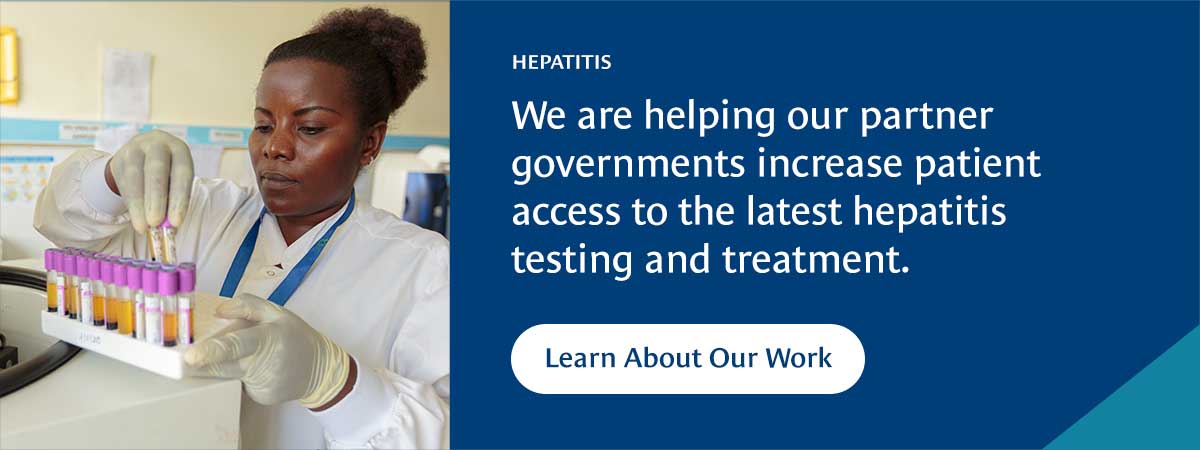CHAI’s recently released Hepatitis C Market Memo is an update to the previous editions of Hepatitis market reports. It provides critical insights into the market and helps the public and private sectors develop better strategies to provide products and services to those who need them.
Every 30 seconds, someone loses their life to a hepatitis-related illness, according to the World Health Organization (WHO). This results in over a million deaths yearly due to hepatitis B (HBV) and hepatitis C infection (HCV). Both these infections are silent killers—patients often don’t experience any symptoms until it is too late.
While we have simpler diagnostic and treatment algorithms, improved therapies, and relatively affordable care that can save these lives, nearly 80 percent of people living with HCV and HBV are unaware of their infection and do not have access to affordable treatment. The WHO’s recent recommendations on HCV diagnostics, treatment, and service delivery promote expanding access through decentralization, integration, and task sharing. And for the first time, treatment is now recommended for all adolescents and children down to the age of three. There is a need to accelerate the fight against viral hepatitis and expedite care for the millions who otherwise will suffer from preventable disease progression and death.
At CHAI, we are focused on supporting countries to eliminate viral hepatitis by 2030 by making hepatitis diagnostics and drugs more affordable and accessible. CHAI continues to support the hepatitis efforts in Cambodia, India, Indonesia, Myanmar, Nigeria, Rwanda, and Vietnam. Our work in these countries and globally over the last seven years includes technical assistance to programs for strengthening service delivery, market shaping work to make commodities accessible, and fostering collaboration to develop a supportive policy environment.
CHAI’s approach to achieving accessible prices for hepatitis commodities has been leveraging volume- and forecast-based pricing strategies, ensuring price transparency, reducing in-country mark-ups along the value chain, and public-private partnerships.
To support the hepatitis community on strategies to build programs with affordable test and treatment commodities, CHAI publishes a viral hepatitis market report annually. The first and second editions of the HCV Market Intelligence Report, released in May 2020 and August 2021, respectively, examine market trends and challenges for hepatitis commodities and serve as a resource for a variety of stakeholders in the global hepatitis community. This year CHAI has launched the Hepatitis C Market Memo, which is an interim update on the market for the HCV diagnostics and treatment market. The memo provides updates on key volume and pricing trends and the availability of quality-assured diagnostic and generic DAA in the market. The memo also sheds light on emerging market frontiers like HCV self-testing and the HCV pediatric market. An interim report on the HBV market will publish later this year, including recommendations for HBV programs and patients to access tenofovir at parity to the low price accessed by HIV programs. Meanwhile, a comprehensive market report on HCV and HBV will be published in 2023.
Sharing market intelligence has helped countries secure better pricing for diagnostics and drugs. Nasarawa state in Nigeria, with the support of partners such as the World Hepatitis Alliance (WHA) and CHAI, for instance, has been able to secure a US$60 per patient course of the sofosbuvir/daclatasvir regimen. A 55 percent reduction from the 2020 price makes HCV cure much more affordable.
CHAI calls for governments and donors to increase investments towards hepatitis services in low- and middle-income countries. Our experience in our partner countries proves that with political will, modest financing, and affordable viral hepatitis commodities, decentralized hepatitis programs are achievable in resource-limited settings, paving the way for elimination.
We hope these market updates will inspire and inform the broader community to build affordable hepatitis programs. At the same time, governments and donors must seize the opportunity to procure commodities at a low price by investing in hepatitis services.







